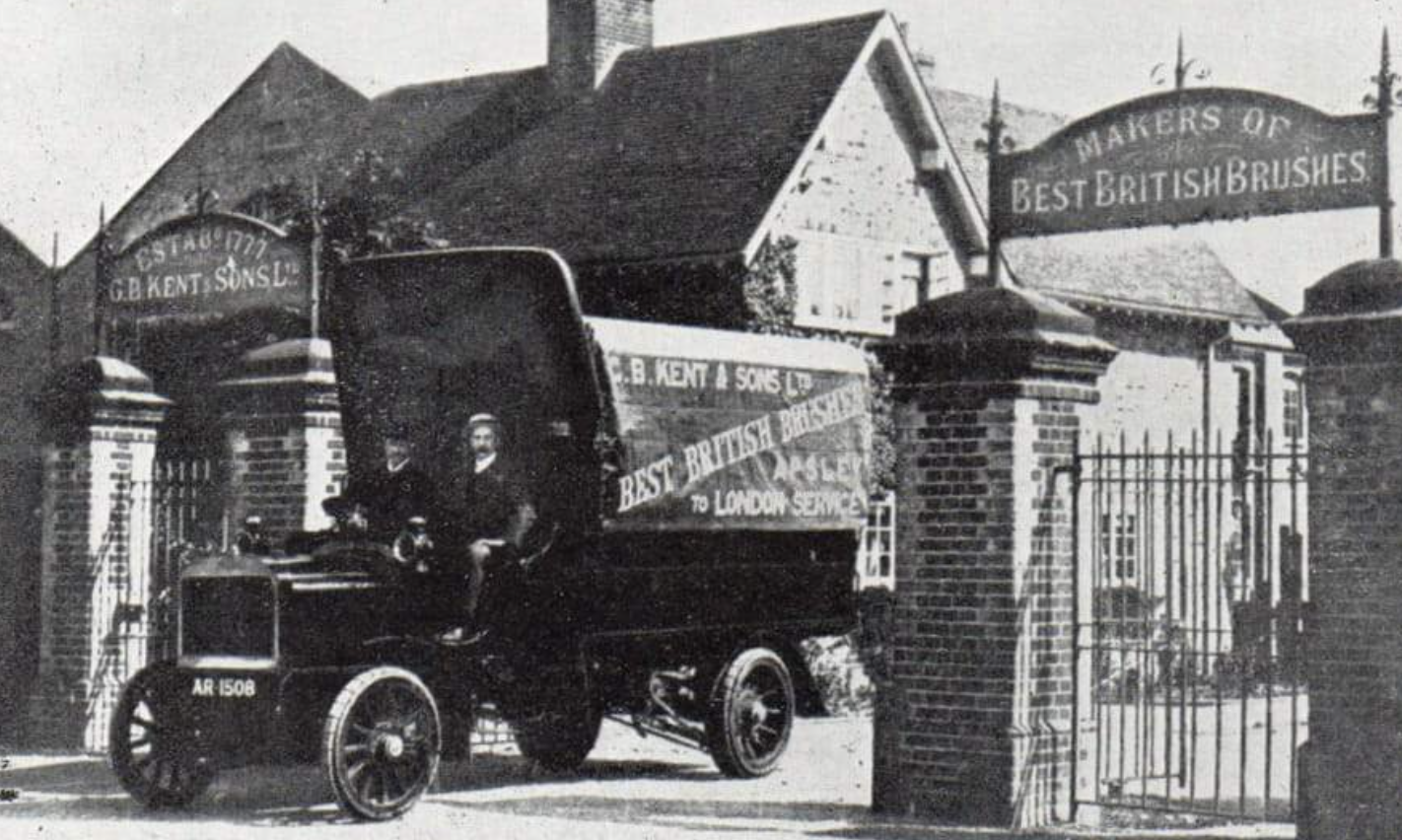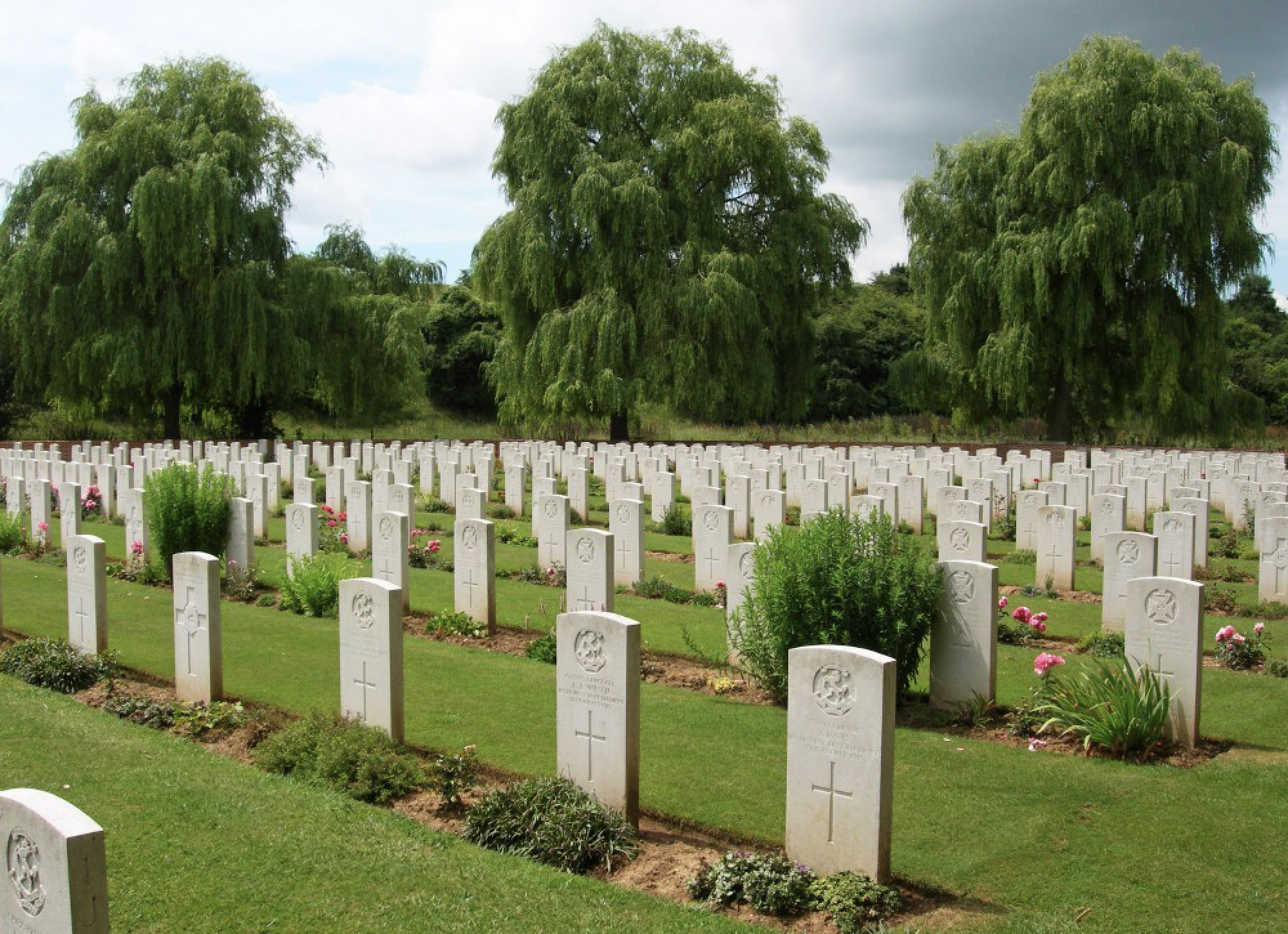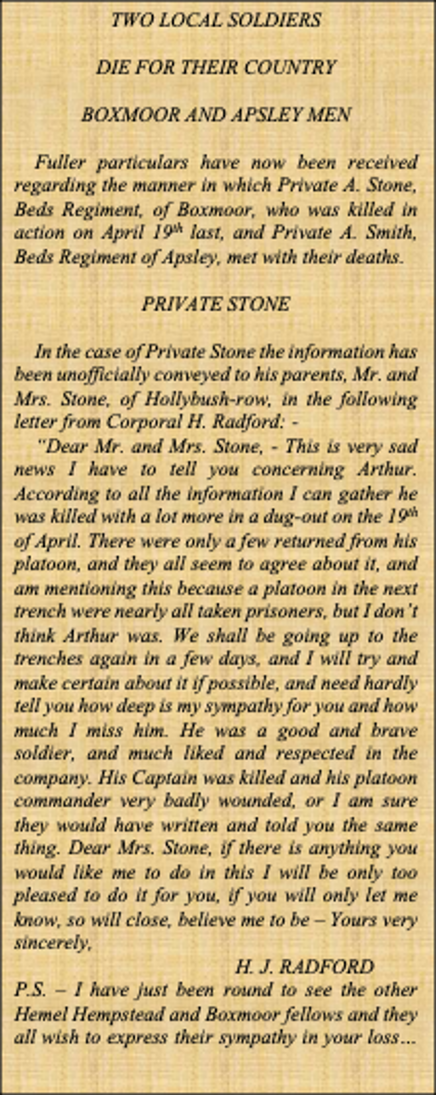Fallen in April 1916:
Albert Edward Owen
Arthur Stone
ALBERT EDWARD OWEN
19162 Private
7th Bn., Bedfordshire Regiment
Killed in Action Friday, 7th April 1916
Remembered with Honour, Carnoy Military Cemetery, Somme, France, Grave L.8.
Albert Edward
Owen was born in Hemel Hempstead on Thursday, 27th December 1894 and
baptised on Friday, 25th October in the following year. He was the
second child born to Edwin Owen and Elizabeth Carrington. Albert had six
siblings who were: Alice, Edith Dorothy, Ethel Annie, William George, Ronald
Harry and the youngest Winifred May.
When Albert and his sister Alice where born, the family lived in Queen’s Place in Hemel Hempstead, a small close just off Queen Street. Just over a year later they had moved to Bury Hill where the Owens would stay until Edwin died in 1931.
By 1911
Albert, aged sixteen, had started work as a Factory Hand with G.B. Kent &
Sons at their brush factory where two of his sisters Alice and Edith also
worked. His father Edwin was as a House Painter.
Following the outbreak of war, Albert enlisted with the Bedfordshire Regiment attesting at Hemel Hempstead in December 1914. He was posted to the 7th Battalion Bedfordshire Regiment and joined his Battalion in January 1916. He trained with the Battalion at Codford near Salisbury for the next seven months until he was mobilised and sent to France.
The 7th Bedfords left Codford with a marching out strength of 820 men and 31 officers and arrived at Folkestone where it embarked with the 54th Brigade HQ on S.S.Onward. The battalion disembarked on the 27th July 1916 at Boulogne-sur-Mer before marching to Ostronove Rest Camp.
Albert spent the next seven months in an area around Fricourt fighting in skirmishes with the enemy but without any major action. Much of the Battalion’s time was taken up with reinforcing and improving trenches although there were regular sorties and night patrols into the German trenches. There were casualties from these patrols and as a result of enemy shelling and sniping, however these were relatively light in the circumstances.
In early March the Battalion moved south to Bray-sur-Somme where the wet and snowy weather made life in the trenches worse than usual and much of Albert’s time was spent repairing trench works. Possibly due to the inclement weather the next few weeks were quiet with only occasional artillery fire from either side. On the 5th April however, the 7th Bedford’s trenches came under increasing threat and the Germans shelled and strafed the Battalion’s position and a number of rifle grenades landed in the trenches.
Two days later Albert was killed when enemy shells again struck the Bedford’s trenches. He was killed instantly on Friday, 7th April 1916.
He is
commemorated on the memorial plaque at G.B. Kent & Sons in Apsley.
Albert is Remembered with Honour in Carnoy Military Cemetery, Somme, France,where he is interred in Grave L.8.
He was 21 years old when he died. Albert was eligible for the 1914-15 Star, the British War Medal and the Allied Victory Medal.
Pte. Albert Owen c1914 (Courtesy: The Hertfordshire, Hemel Hempstead Gazette and West Herts Advertiser)
G.B. Kent & Sons where Albert worked (Courtesy:https://kentbrushes.com/)
G.B.Kent & Sons Memorial Plaque (Courtesy: http://www.hemelatwar.org)
Carnoy Military Cemetery, Somme, France (Courtesy: CWGC)
ARTHUR STONE
16689 Private
8th Bn.,
Bedfordshire Regiment
Died of Wounds Wednesday, 19th April
1916
Remembered with Honour, Ypres (Menin Gate)
Memorial, West-Vlaanderen, Belgium, Panel 33
Arthur
Stone was born in 1885 in Boxmoor the oldest child of George Stone and Mary Ann
Harriet Odell who had twelve children in total, two of whom died young. Arthur’s
five sisters who lived were: Louisa, Emily, Elizabeth, Hilda and Milly. His four
brothers were: William, Alfred, George and Fred. His brother Alfred also fought
and died in the Great War. He was killed on the 13th July 1916 only
three months after Arthur. His biography also appears on this site.
When Arthur was born his parents lived at 34 London Road in the Two Waters area of Boxmoor in the home where all eleven children grew up.
Arthur attended nearby Two Waters British School and in April 1890 his teacher recorded the fact that “..the Guardians have discontinued to pay the Fees for Thomas Kitchener, Arthur Stone…” and naming five other pupils. When a parent could not meet the school fees, the Attendance Officer of the School Board could make an application to the Board of Guardians for the fees to be paid by them. It is unclear why the Guardians had stopped paying Arthur’s fees, but the result would have meant his exclusion from school. Arthur’s father George worked as a General Labourer so may not have earned enough to pay for his son to stay in school.
In 1890 a school like Two Waters would charge approximately 12d per year (equivalent to sixty-two pence today) for each pupil which perhaps does not sound like a lot. But given that Arthur’s father George worked as a General Labourer on about three shillings per week and with a wife, three young children (two at school) and his mother-in-law to support, his meagre wage probably did not stretch far enough to afford the school fees.
By 1901, Arthur aged sixteen and his younger sister Louisa, had started work with John Dickinson & Co. Ltd. as an Envelope Packer and Black Borderer respectively. This would have helped supplement the income of George’s growing family which had now reached a total of nine.
In 1911 Arthur and four of his younger siblings worked at Dickinsons and the family of eleven lived in a two up two down house still on London Road, Boxmoor. It seems that Arthur left Dickinsons sometime after 1911 and before war was declared, although it is not known where he went to work.
On the outbreak of war Arthur enlisted with the Bedfordshire Regiment, attesting in Watford in September 1914 and being posted to the 8th Battalion (the "Hungry 8th" as it became known). He was sent with the Battalion to Woking where basic training was carried out and after a long wait, Arthur was eventually mobilised in August of the following year.
He disembarked at Boulogne-sur-Mer on the 30th August 1915 and less than a month later saw action in the Battle of Loos. Arthur survived Loos and the first use of poison gas by the German’s in December. Between January and April 1916 he was with the Battalion in a sector of the Front Line close to Ypres beside the Yser Canal.
The Battalion War Diary records events on the 19th and 20th April as follows: "20 Apr 1916 - Battalion moved back in support in dugouts on YSER CANAL - *On night 19/20 Apl. after 2 hours heavy bombardment Germans attacked and gained a footing in trenches D20, WILLOW WALK and S18a - D21, B17a and B16 still held by battalion and line VICARS LANE - CLIFFORD TOWER - GANTHORPE ROAD strengthened and reinforced. Killed - Capt Quilter, 2Lt Cartwright, 2Lt.McMichael. Wounded 2Lt Vipond, 2Lt Player, 2Lt Charles. Missing 2Lt Squier. O.Ranks - Killed 32, Missing believed Killed 97, Wounded 65."
Arthur was one of the ninety-seven men missing believed killed and his death date was officially recorded as Wednesday, 19th April 1916.
The following
month a fellow soldier, H.J. (Harry) Radford, wrote to Arthur’s parents to give
them the tragic news and this was reported in the Hemel Gazette. Harry Radford
would also suffer the loss of his youngest brother Colin who was killed in July
1917. His biography appears on this site. (see extract)
Arthur is Remembered
with Honour on the Ypres (Menin Gate) Memorial,
West-Vlaanderen, Belgium, Panel 33 .
He was 31 years old when he died. Arthur was eligible for the 1914-15 Star, the British War Medal and the Allied Victory Medal.
Arthur Stone c1912 (Courtesy: The Hertfordshire, Hemel Hempstead Gazette and West Herts Advertiser)
Extract from the Hertfordshire, Hemel Hempstead Gazette and West Herts Advertiser 20th May 1916
Ypres (Menin Gate) Memorial, West-Vlaanderen, Belgium (Courtesy: CWGC)



